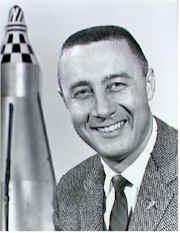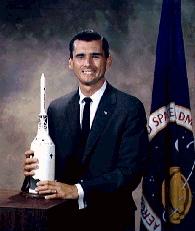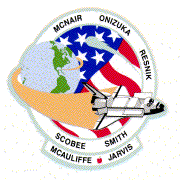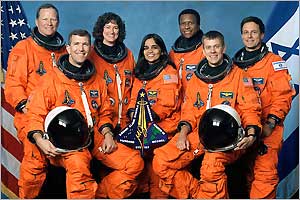


DEDICATION: REMEMBERING ALL THE HEROES
The wrecked spaceships and the dead astronauts (Landon, Dodge, Stewart, Skipper, Jones) would be echoed all too eerily in real life during the Space Race that occupied the mindsets of the American and Russian people during the two decades that were the 1950's and the 1960's as well as several years into the early '70's. Tensions between the two super powers seemed to lessen somewhat with the historic Apollo-Soyuz linkup, which symbolized that space might not become a orbital battleground like so many sci-fi authors and pessimists believed it would, but that perhaps, mutual cooperation could be used to explore space, and extend mankind past his home.



The visual images of the crippled "Icarus" slowly vanishing beneath the waves could be seen as a direct analogy of Gus Grissom's "LIBERTY BELL 7" capsule sinking on its return to Earth; both were representations of America's first steps into space, both in fantasy and in reality. Gus Grissom escaping from his sinking capsule might have been alluded to in Planet of the Apes, but Grissom's death several years later would awaken the public to the fact that space travel was not without hazards that required the ultimate sacrifice to be paid, some of them before the flight ever left the planet.
Grissom's fate was postponed until his Apollo 1 mission. Unlike Taylor, Dodge, and Landon, Gus Grissom and his crew never had a chance to escape their stricken spaceship. They died in the cockpit, their space craft became their tomb...



That one incident really set home the fact that travel beyond this planet, beyond this comfortable existence, was done with a great amount of risk and was anything other than routine. A few years after Planet of the Apes, Apollo 13 would also prove that space travel was inherently a dangerous journey and anything but routine. The greatest fear of every astronaut is to find out that the stowaway aboard their spacecraft is none other than Murphy.
There have been many astronauts that have died for the cause of exploration, for the advancement of the human race as a whole, and in service to their countries in particular. For although the Space Race was a politically charged exercise in muscle flexing, it's benefits have outlasted the tensions that originally gave it birth, and have brought miraculous wonders to all of mankind. The the advent of NASA constructing a international space station, the endeavor of many nations including Russia, we see that maybe these brave souls' sacrifice might not have been in vain. Exploration knows no flags, it is an adventurous spirit that is inherent in all humans, regardless of race, creed, sex or any other trait which we have used to (vainly) separate us from members of our same species.
ALL THE DEAD HEROES
![]()
March 23, 1961- Russia- Soyuz
Oxygen rich flash fire inside capsule prior to launch

Valentine Vonderenko
![]()
January 27, 1967- United
States- Apollo 1
Oxygen rich flash fire inside capsule prior to launch



Virgil "Gus"
Grissom
Edward White
Rodger Chaffe

![]()
April 23, 1967- Russia- Soyuz-1
Parachutes failed to
deploy correctly on reentry resulting in catastrophic vehicle crash

Vladimir Komarov
![]()
March 27, 1968- Russia-
MiG-15 crash during training

Col. Yuri Alexeyevich Gagarin
![]()
June 30, 1971- Russia- a
valve opened prematurely upon reentry
fatally depressurizing the Vostok capsule



Georgi Dobrovolsky Viktor Patsayev Vladislav Volkov
![]()
January 28, 1986- United States, Space Shuttle Challenger- STS51L-
O-ring failure on booster rocket
initiated catastrophic destruction
of entire shuttle vehicle seconds after launch

McNair, Onizuka, Resnik, Scobee, Smith, McAuliffe, Jarvis
STS51L was to go down in history as the first teacher in space. Instead, it became a disaster the likes of which NASA almost didn't recover from.


![]()
February 1st, 2003- United States, Space Shuttle Columbia- STS107-
Heat tile failure on left wing initiated catastrophic destruction of entire shuttle vehicle upon reentry

Columbia crew, l-r,
Front row:
Rick Husband, Kalpana Chawla, William McCool.
Back row: David Brown, Laurel Clark, Michael Anderson and Ilan Ramon
CAPE CANAVERAL, Fla. — Space Shuttle
Columbia blew up and disintegrated in flames 39 miles over Texas Saturday morning, killing
all seven astronauts aboard and scattering debris over up to four states and the Gulf of
Mexico.
The sight of the shuttle breaking up above the Earth and sending a meteoric streak of
smoking debris hurling across the sky was horrifyingly reminiscent of the Challenger
disaster almost exactly 17 years ago to the day.
The seven crew members -- six Americans and the first Israeli to go into space -- were
scheduled to touch down in just 16 minutes at Cape Canaveral, Fla., when the shuttle broke
up at 207,135 feet. The astronauts had been orbiting the Earth for 16 days.
"Columbia is lost. There are no survivors," President Bush said in a televised
address from the Cabinet Room. He said the day had brought "terrible news" and
"great sadness" to the country, and that "our entire nation grieves."
The president ordered flags to be lowered to half-staff at all government buildings.
An independent commission was appointed to investigate the cause of the tragedy, which was
not immediately known.
The probe could potentially focus on possible damage to the protective thermal tiles on
the left wing of the shuttle. A piece of insulating foam broke off from the external fuel
tank during the Jan. 16 liftoff and may have knocked against the wing.
Leroy Cain, the lead flight director in Mission Control, assured reporters Friday that
engineers had concluded that any damage to the wing was considered minor and posed no
safety hazard.
NASA said the first indication of trouble Saturday was the loss of temperature sensors in
that wing's hydraulic system.
The spacecraft had just re-entered the atmosphere and had reached the point at which it
was subjected to the highest temperatures.
Authorities said there was no indication of terrorism; at 207,135 feet, the shuttle was
out of range of any surface-to-air missile, a senior government official said. Security
was extraordinarily tight on the mission because Ilan Ramon, Israel's first astronaut, was
among the crew members.
Television footage showed a bright light followed by white smoke plumes streaking
diagonally through the brilliant, blue sky. Debris appeared to break off into separate
balls of light as it continued downward.
Military satellites with infrared detectors recorded several flashes as Columbia broke
apart, according to a defense official who spoke on condition of anonymity. It was unclear
whether those "spikes" of heat indicated an explosion, the burning of pieces of
debris re-entering the atmosphere or something else.
"We saw it coming across the sky real bright and shiny and all in one piece. We
thought it was the sun shining off an airplane," said Doug Ruby, who was driving with
his father along a Texas highway, headed for a fishing trip. "Then it broke up in
about six pieces -- they were all balls of fire -- before it went over the tree
line."
Pieces of the spacecraft were found in several east Texas counties and in Louisiana. There
also were unsubstantiated reports of debris in New Mexico and Arkansas.
There was at least one report of human remains recovered. In Hemphill, Texas, near the
Louisiana line, a hospital employee on his way to work reported finding what appeared to
be a charred torso, thigh bone and skull on a rural road near what was believed to be
other debris.
The FAA issued a notice to airmen because the National Weather Service radar picked up a
debris cloud about 95 miles long and 13 to 22 miles wide over Lake Charles, La.
The Army's 1st Cavalry Division sent a helicopter search-and-rescue task force from Fort
Hood, Texas. NASA also asked members of the public to help in its search for debris, but
warned people not to touch the pieces because they might be contaminated with toxic
propellants.
The shuttle flight was the 113th in the shuttle program's 22 years and the 28th flight for
Columbia, NASA oldest shuttle.
The horrific end of shuttle mission STS-107 was a devastating blow to the nation's space
program; the Challenger explosion led to a 2-year moratorium on launches, and Saturday's
accident could bring construction of the international space station to a standstill.
The shuttle delivers components of the space station to be installed; it also carries
crews to and from the station. The three astronauts now on board the station could return
to Earth at a moment's notice via a Russian vehicle attached to the space station.
The loss of the seven astronauts -- shuttle commander Rick Husband, Michael Anderson,
David Brown, Kalpana Chawla, Laurel Clark, William McCool and Ramon -- brought a new round
of grief to a nation still in mourning after the terrorist attacks of Sept. 11, 2001, and
to a NASA program that will never forget the 1986 Challenger disaster.
"We trust the prayers of the nation will be with them and with their families. A more
courageous group of people you could not have hoped to know," said NASA Administrator
Sean O'Keefe.
Columbia had been scheduled to land at Kennedy Space Center at 9:16 a.m.
Shuttle program manager Ron Dittemore said "there was no indication of any impending
threats to the vehicle." Then there was a loss of data from temperature sensors on
the left wing, followed by a loss of data from tire pressure indicators on the left main
landing gear.
The final radio transmission between Mission Control and the shuttle, at 9 a.m., gave no
indication of any trouble.
Mission Control radioed: "Columbia, Houston, we see your tire pressure messages and
we did not copy your last."
Columbia's commander, Rick Husband, calmly responded: "Roger, buh ..."
For several seconds, the transmission went silent.
Then, there was static.
Texas Sen. Kay Bailey Hutchison, in her Dallas neighborhood, said she heard a "boom,
which I thought was the breaking of the sound barrier" -- and it may have been just
that, because the shuttle was traveling at 12,500 mph, 18 times the speed of sound.
"The barn started shaking and we ran out and started looking around," said
Benjamin Laster of Kemp, Texas. "I saw a puff of vapor and smoke and saw big chunk of
material fall."
• Map: Witness/Debris Sightings
On the edge of downtown Nacogdoches, 135 miles northeast of Houston, a National Guardsman
stood watch over a steel rod with silver bolts that landed in the grass outside a yard.
People streamed up to take photos of the debris.
Jeff Hancock, a dentist, said a metal bracket about a foot long had crashed through his
office roof.
"It's all over Nacogdoches," said James Milford, owner of a downtown barber
shop. "There are several little pieces, some parts of machinery. ... There's been a
lot of pieces about 3 feet wide."
In 42 years of U.S. human spaceflight, there had never been an accident during descent or
landing.
Two hours after the shuttle had been expected to land, the giant screen at the front of
Mission Control showed a map of the southwestern United States and what should have been
Columbia's flight path. The American flag next to the center's countdown clock was lowered
to half-staff.
O'Keefe met with the astronauts' families, who had been waiting at the landing site for
the shuttle's return. Six of the seven astronauts were married, and five had children.
Former astronaut John Glenn, the first American to orbit the Earth, and his wife were
watching on television at their home in Maryland.
"Anytime you lose contact like that, there's some big problem. Of course, once you
went for several minutes without any contact, you knew something was terribly wrong,"
Glenn said.
The shuttle is essentially a glider during the hour-long descent from orbit toward the
landing strip. It is covered by about 20,000 thermal tiles to protect against temperatures
as high as 3,000 degrees.
Columbia's crew had completed 80-plus scientific research experiments during their time in
orbit. It was a relatively inexperienced crew; only three -- Husband, Anderson and Chawla
-- had ever flown before.
The others were rookies, including Ramon, the 48-year-old Israeli Air Force colonel. A
former fighter pilot who survived two wars, he carried into space a small pencil drawing
titled "Moon Landscape" by Peter Ginz, a 14-year-old Jewish boy killed at
Auschwitz.
"The government of Israel and the people of Israel are praying together with the
entire world for the safety of the astronauts on the shuttle Columbia," Prime
Minister Ariel Sharon's office said in a statement. "The state of Israel and its
citizens are as one at this difficult time."
Dr. Yael Barr of the Israeli Aerospace Medicine Institute was waiting at the landing strip
for the astronauts' return.
"When the countdown clock, when it got to zero and then started going, instead of
counting down, counting up and they were still not there, I told my friend, 'I have a bad
feeling. I think they are gone.' And I was in tears," Barr said.
Just in the past week, NASA observed the anniversary of its only two other space
tragedies, the Challenger explosion on Jan. 28, 1986, and the Apollo spacecraft fire that
killed three on Jan. 27, 1967.

Columbia breaking up in the blue skies
over Texas.
An image that will never be forgotten by those who
witnessed it.

"The same Creator who names the stars also knows the names
of the seven souls we mourn today. The crew of the shuttle Columbia did not return safely
to Earth; yet we can pray that all are safely home." -President
G.W. Bush, Feb 1, 2003
Humanity often forgets who the true heroes are, but some of us do not. There are no heroes on the football field, there are no heroes on the race track, and there are no heroes shooting hoops or whacking little white balls 300 yards into a cup sized hole in the ground. Civilization and society's heroes rise much higher than that.
Goodbye Columbia. Godspeed to the crew.
![]()
"And with that risk came a great amount of respect for those who ventured beyond this existence, who slipped the surly bonds of this Earth, and reached forward to heaven to touch the face of God ..."
